ตำรามาตรฐานยาสมุนไพรไทย
Thai Herbal Pharmacopoeia
สำนักยาและวัตถุเสพติด กรมวิทยาศาสตร์การแพทย์ กระทรวงสาธารณสุข
Bureau of Drug and Narcotic, Department of Medical Sciences, Ministry of Public Health(Tinospora crispa (L.) Hook.f. & Thomson)
(Nelumbo nucifera Gaertn.)
(Centella asiatica (L.) Urb.)
(Centella Dry Extract)
(Centella Cream)
(Mesua ferrea L.)
(Piper sarmentosum Roxb.)
(Piper sarmentosum Roxb.)
(Pterocarpus santalinus L. f.)
(Santalum album L.)
(Senna tora (L.) Roxb.)
(Senna alata (L.) Roxb.)
(Senna Alata Tea)
(Piper retrofractum Vahl)
(Myristica fragrans Houtt)
(Andrographis paniculata (Burm. f.) Nees)
(Andrographis Capsules)
(Allium ascalonicum L.)
(Ocimum tenuiflorum L.)
(Curcuma longa L.)
(Turmeric Capsules)
(Turmeric Dry Extract)
(Turmeric Dry Extract Capsules)
(Arcangelisia flava (L.) Merr.)
(Curcuma sp.)
Harrisonia perforata (Blanco) Merr.
(Aristolochia pierrei Lecomte)
(Zingiber officinale Roscoe)
(Ginger Capsules)
(Ginger Tea)
(Cassia fistula L.)
(Nardostachys jatamansi (D. Don) DC.)
(Angelica sinensis (Oliv.) Diels)
Artemisia annua L.
(Ligusticum sinense Oliv. cv. Chuanxiong)
(Neopicrorhiza scrophulariiflora Pennell)
(Atractylodes lancea (Thunb.) DC.)
(Aucklandia lappa Decne)
(Terminalia chebula Retz.)
(Angelica dahurica (Hoffm.) Benth. & Hook. f. ex Franch. & Sav. var. dahurica)
(Kaempferia parviflora Wall. ex Baker)
(Hibiscus sabdariffa L.)
(Roselle Tea)
(Allium sativum L.)
(Zingiber zerumbet (L.) Sm.)
(Wurfbainia testacea (Ridl.) Škorničk.& A. D. Poulsen)
(Cannabis sativa L.)
(Myristica fragrans Houtt)
(Dracaena cochinchinensis (Lour.) S. C. Chen)
(Ficus racemosa L.)
(Hyptis suaveolens (L.) Poit.)
Clerodendrum indicum (L.) Kuntze
(Phyllanthus emblica L.)
(Citrus hystrix DC.)
(Citrus hystrix DC.)
(Areca catechu L.)
(Momordica charantia L.)
Moringa oleifera Lam.
(Aegle marmelos (L.) Corrêa)
(Solanum trilobatum L.)
(Morus alba L.)
Gynostemma pentaphyllum(Thunb.)
Makino
(Clinacanthus nutans (Burm. f.) Lindau)
(Cissus quadrangularis L.)
(Mimusops elengi L.)
(Zingiber montanum (J. König) Link. ex A. Dietr.)
(Piper betle L.)
(Capsicum annuum L.)
(Capsicum Oleoresin)
(Capsicum Gel)
(Piper nigrum L.)
(Piper nigrum L.)
(Eurycoma longifolia Jack)
(Thunbergia laurifolia Lindl.)
(Piper wallichii (Miq.) Hand.-Mazz.)
Senna garrettiana (Craib) H. S. Irwin & Barneby
(Terminalia bellirica (Gaertn.) Roxb.)
(Terminalia chebula Retz.)
(Caesalpinia bonduc (L.) H. Roxb.)
(Tarlmounia elliptica (DC.) H. Rob., S. C. Keeley, Skvaria & R. Chan)
(Hog Creeper Vine Dry Extract Capsiles)
(Hog Creeper Vine Dry Extract)
(Brachypterum scandens (Roxb.) Miq.)
(Lepidium sativum L.)
(Nigella sativa L.)
(Cuminum cyminum L.)
(Foeniculum vulgare Mill.)
(Plantago ovata Forssk.)
(Pimpinella anisum L.)
(Carum carvi L.)
(Anethum graveolens L.)
(Trachyspermum ammi (L.) Sprague)
Albizia procera (Roxb.) Benth.
(Acorus calamus L.)
(Tiliacora triandra (Colebr.) Diels)
Cyanthillium cinereum (L.) H. Rob.
(Orthosiphon aristatus (Blume) Miq.)
Murdannia loriformis (Hassk.) R. S. Rao & Kammathy
(Capparis micracantha DC.)
(Chrysopogon zizanioides (L.) Roberty)
(Cyperus rotundus L.)
(Cannabis sativa L.)
(Syzygium aromaticum (L.) Merr. & L. M. Perry)
(Boesenbergia rotunda (L.) Mansf.)
(Acanthus ebracteatus Vahl)
(Acanthus ilicifolius L.)
(Kaempferia galanga L.)
(Curcuma comosa Roxb.)
Betula alnoides Buch.-Ham. ex D. Don
Cannabis sativa L.
Carthamus tinctorius L
Mitragyna speciosa (Korth.) Havil
Mallotus repandus (Rottler) Müll. Arg
Azadirachta indica A. Juss. var. siamensis Valeton
Azadirachta indica A. Juss. var. siamensis Valeton
Punica granatum L.
Rhinacanthus nasutus (L.) Kurz
Baliospermum solanifolium (Burm.) Suresh
Curcuma aeruginosa Roxb
Boesenbergia kingii Mood & L. M. Prince
Senegalia rugata (Lam.) Britton & Rose
Acacia concinna (Willd.) DC.
Senegalia rugata (Lam.) Britton & Rose
Acacia concinna (Willd.) DC.
Senna alexandriana Mill. var. alexandriana
Cassia acutifolia Delile, Cassia angustifolia Vahl
Butea superba Roxb. ex Willd.
[Plaso superba (Roxb. ex Willd.) Kuntze, Rudolphia superba (Roxb. ex Willd.) Poir.
Pueraria candollei Graham
ex Benth. var. mirifica (Airy Shaw & Suvat.) Niyomdham
Streblus asper Lour.
Suregada multiflora (A. Juss.) Baill. (Gelonium
multiflorum A. Juss.
Clove is the dried mature flowering bud of Syzygium aromaticum (L.) Merr. & L. M. Perry [Caryophyllus aromaticus L., C. hortensis Noronha, C. silvestris Teijsm. ex Hassk., Eugenia caryophyllata Thunb., E. caryophyllus (Spreng.) Bullock & S. G. Harrison, Jambosa caryophyllus (Thunb.) Nied., Myrtus caryophyllus Spreng.] (Family Myrtaceae), Crude Drug Number: DMSc 1195.
Constituents Clove contains a volatile oil, of which eugenol is its major component. It also contains tannins, flavonoids, triterpenes, sterols, etc.
Description of the plant (Fig. 1) Evergreen tree 9 to 20 m tall; stem erect, twig terete; bark smooth, whitish grey or pale brown. Leaves simple, opposite, lanceolate, narrowly elliptic or narrowly obovate, 6 to 14 cm long, 2.5 to 6 cm wide, apex acute or acuminate, base narrowly cuneate, margin entire, coriaceous, shiny, oil glands abundant, midrib impressed on upper surface, secondary veins 15 to 20 pairs, intramarginal vein 1; petiole slender, 1 to 2.5 cm long. Inflorescence terminal corymbose, trichotomous, up to 5 cm long; peduncle up to 1 cm long or absent; bract and bracteole triangular, 2 to 3 mm long. Flower pale yellow, greenish yellow or greenish white; pedicel 3 to 7 mm long; hypanthial cup cylindric, 1 to 1.5 cm long, angled, slightly narrow at base; sepals 4, free, narrowly ovate, 3.5 to 4.2 mm long, apex acute, margin entire and hyaline, red at anthesis; petals 4, free, oblong or orbicular, 7 to 8.4 mm
long, margin hyaline with numerous gland dots, caducous; stamens numerous, caducous, filament about 7 mm long, anther ovoid or oblong-ovoid, about 0.5 mm long; ovary inferior, 2-loculed, ovules many per locule, style stout, about 4 mm long. Fruit a berry, obovoid or oblong-ovoid, 2 to 2.5 cm long, 3 to 6 mm in diameter, reddish to dark brown. Seeds 1 or more.
Description Odour, strongly aromatic, characteristic; taste, pungent, spicy and numb.
Macroscopical (Fig. 1) Pestle-shaped, 1.5 to 2 cm long; crown 3 to 5 mm in diameter, petals 4, imbricated, dark brown to brownish yellow, enclosing stamens and style, numerous yellow and granular anthers visible after rubbing into pieces. Calyx attached to hypanthium, apex slightly curved. Hypanthium cylinder, 0.7 to 1.4 cm long, 3 to 6 mm in diameter, reddish brown or dark brown, sepals 4, triangular, occurring at the upper part, separating in cruciform. Texture hard, oily.
Microscopical (Figs. 2a, 2b, 2c, 2d, 2e, 2f, 2g) Transverse section of the petal shows upper epidermis, mesophyll, vascular tissue, and lower epidermis. Upper epidermis: a layer of thick-walled rectangular cells, a few slightly raised stomata and covered with thick cuticle layer. Mesophyll: thick- and wavy-walled parenchyma, some containing oil droplets, starch grains and rosette aggregate crystals; 1 to 2 rows of ovoid schizogenous oil glands near epidermal layer and angular collenchyma. Vascular tissue: bicollateral bundles and pericyclic fibres. Lower epidermis: a layer of thick-walled rectangular cells, and covered with thick cuticle layer.

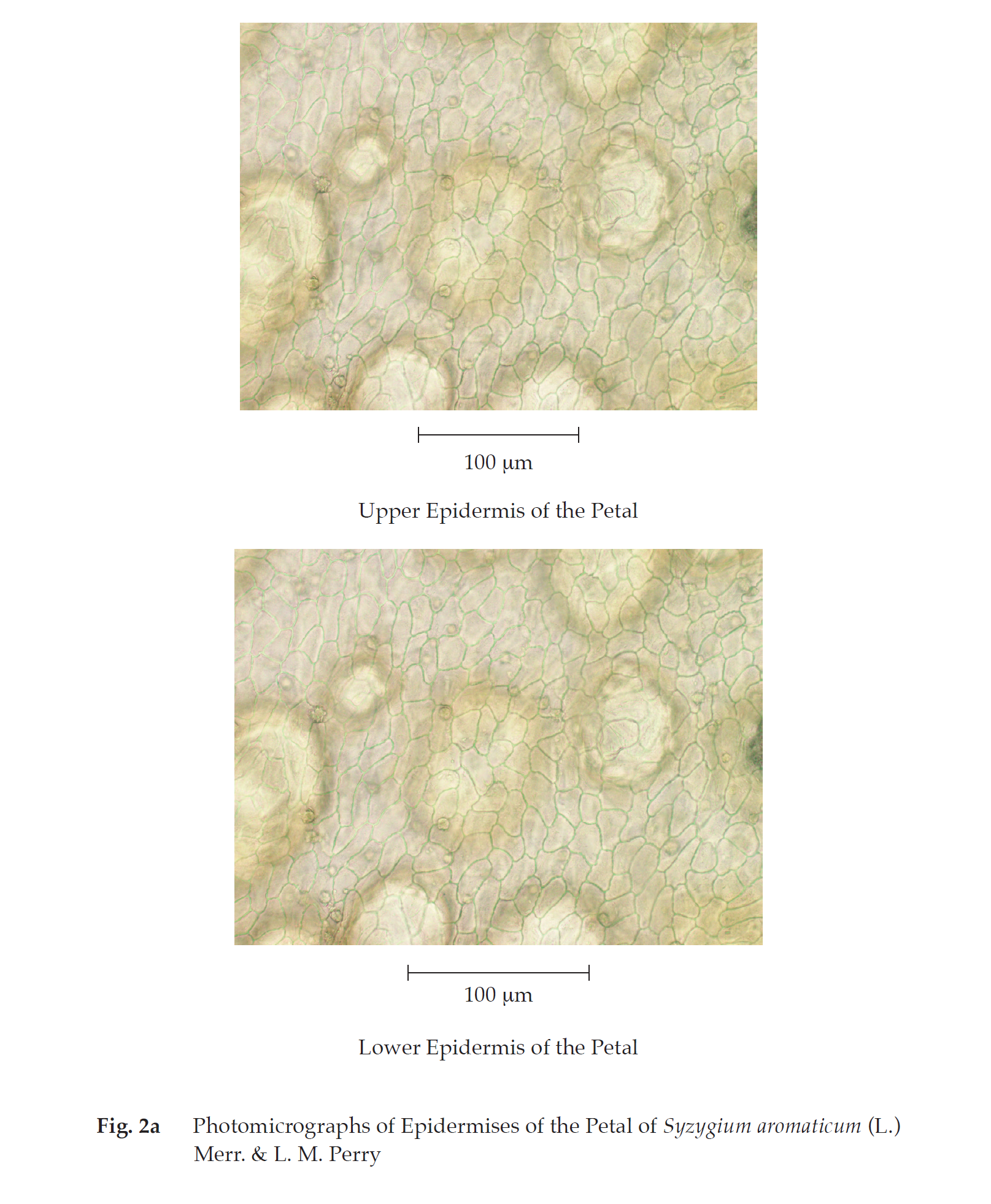
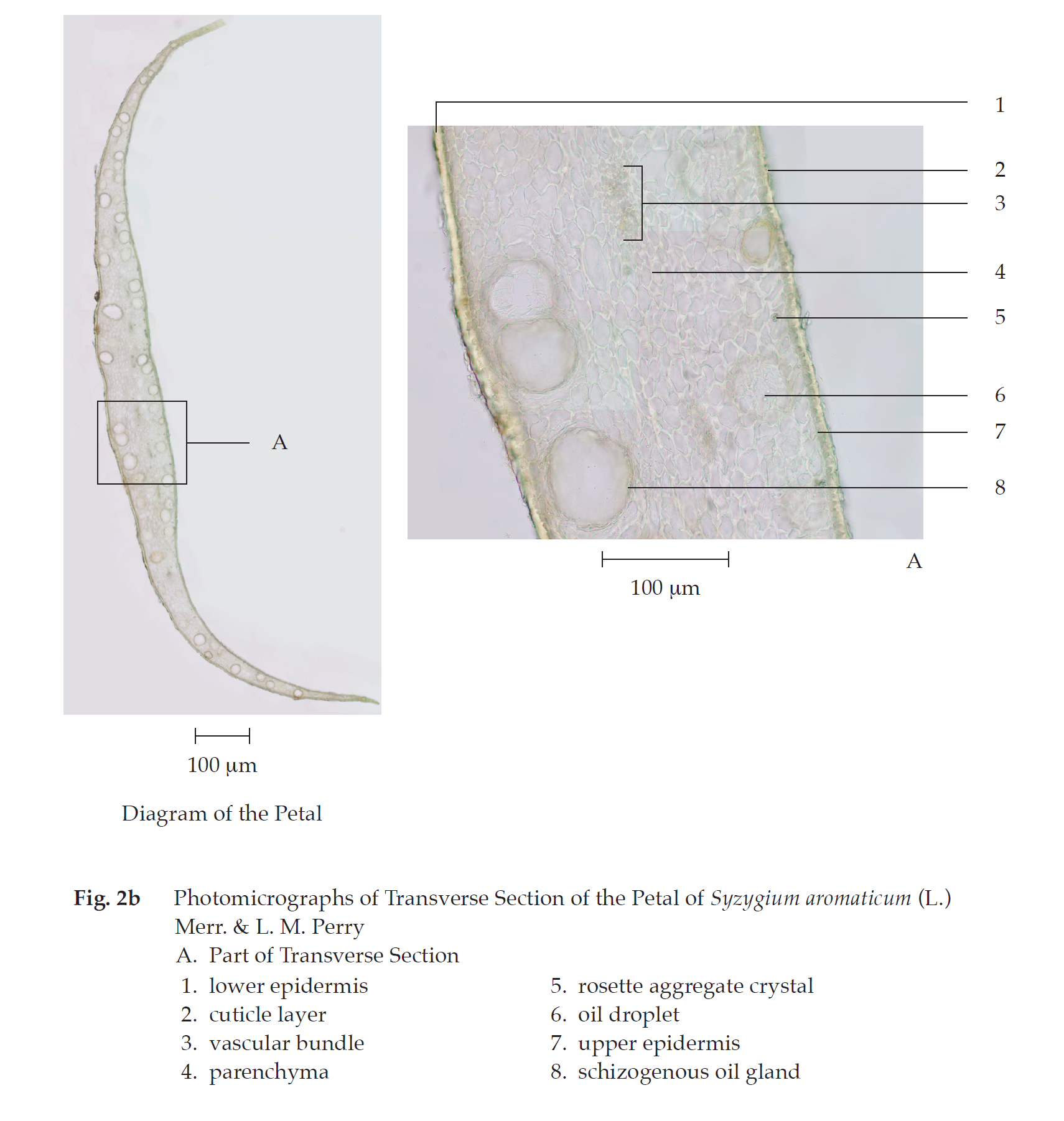
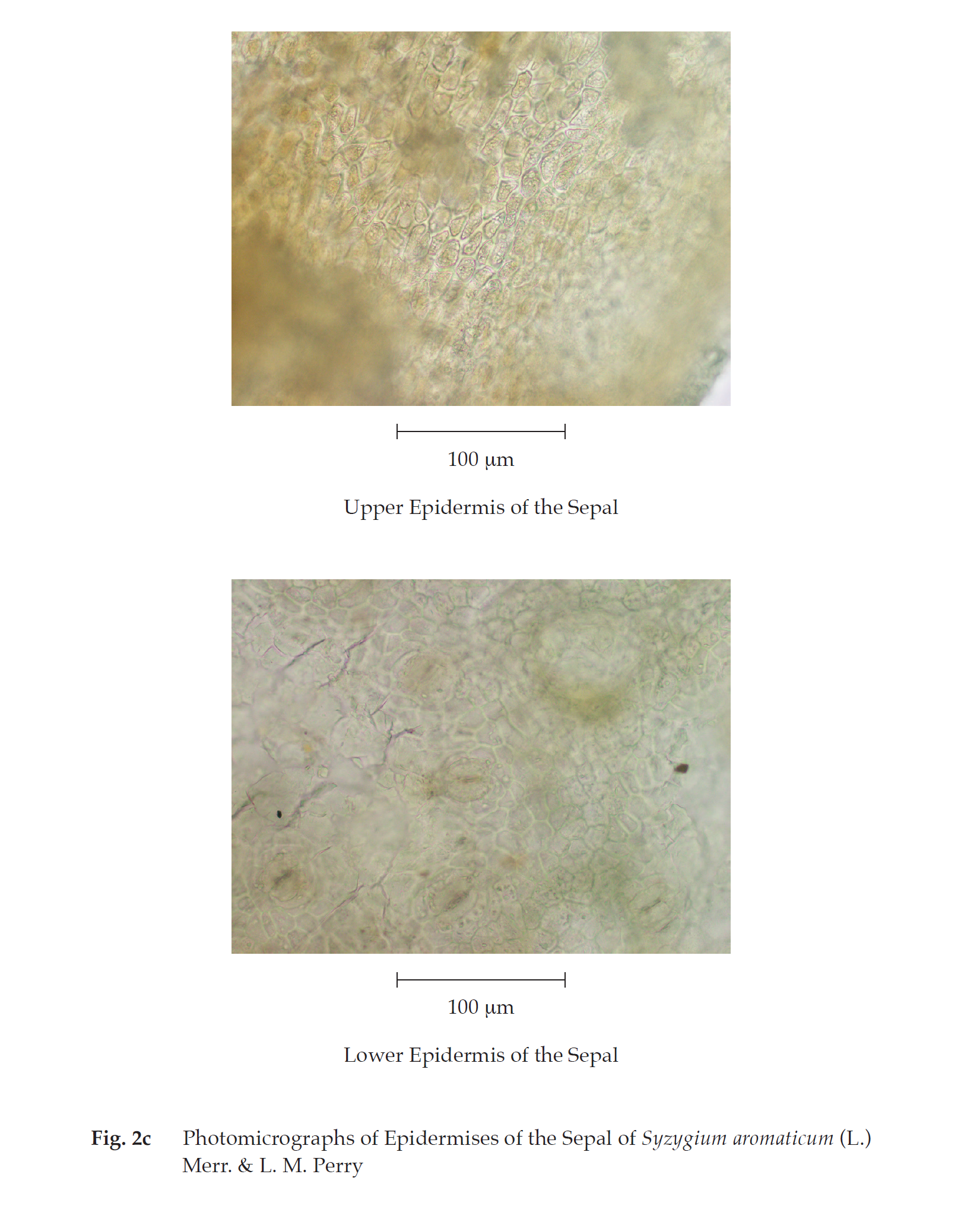
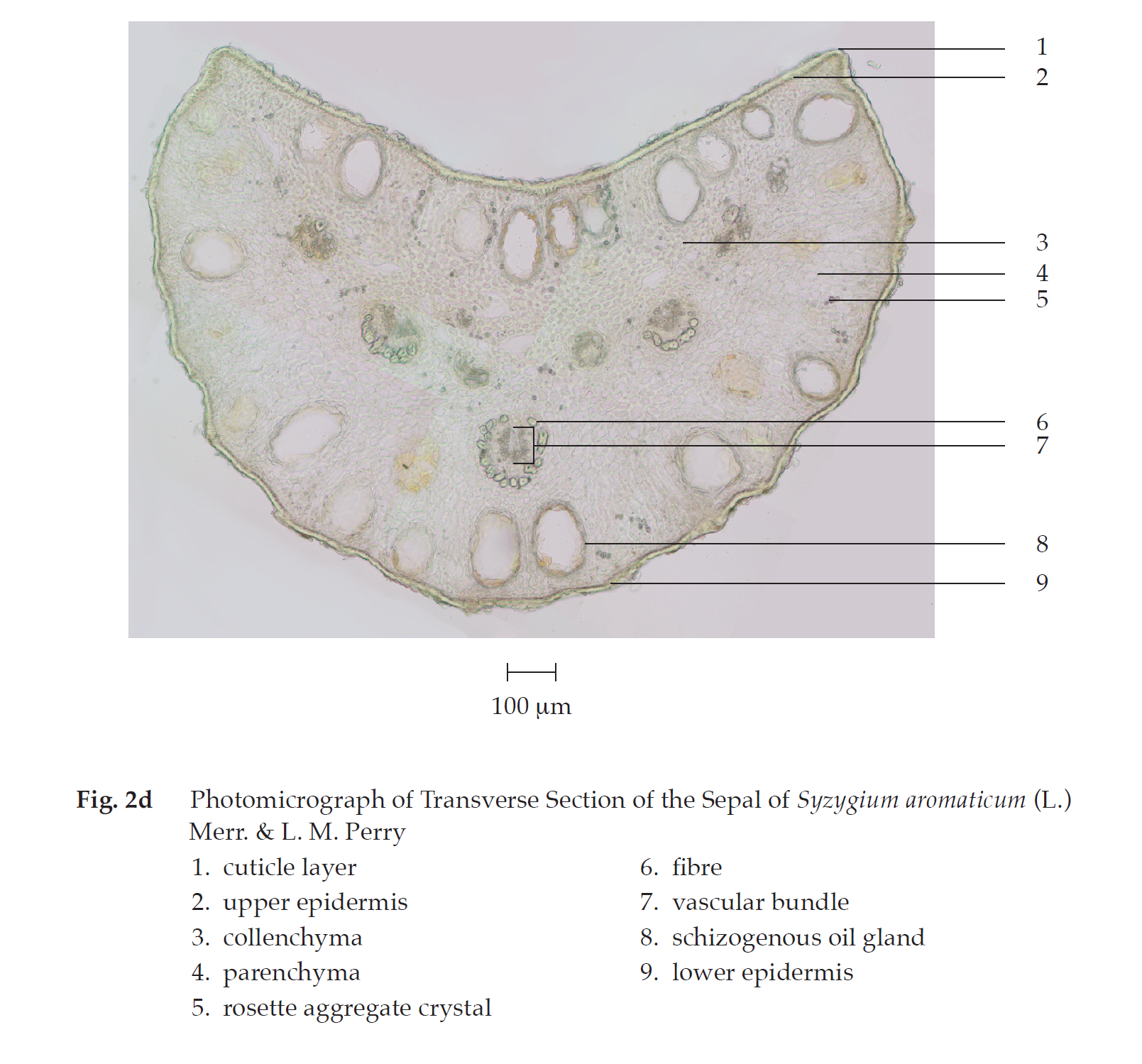
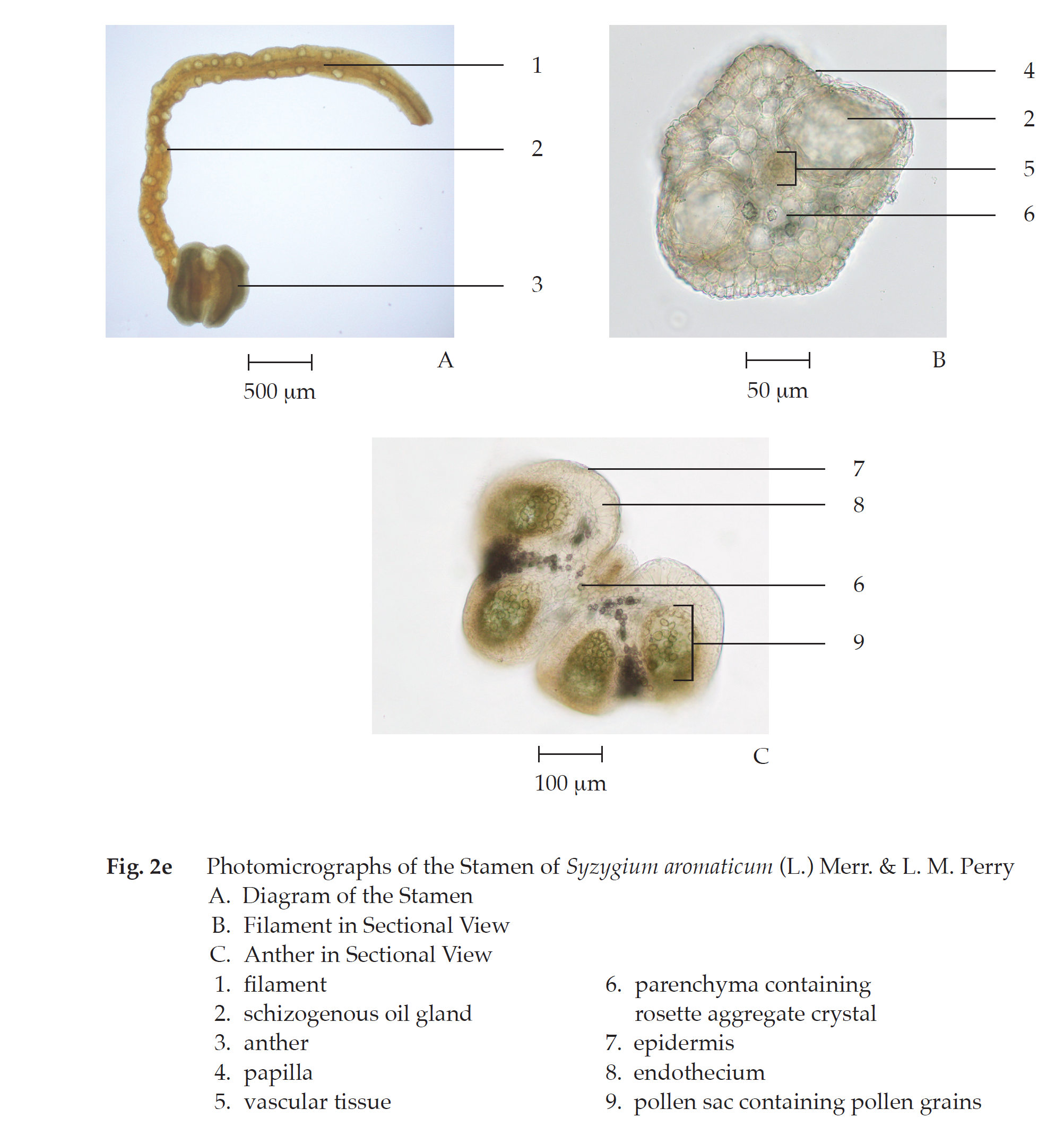
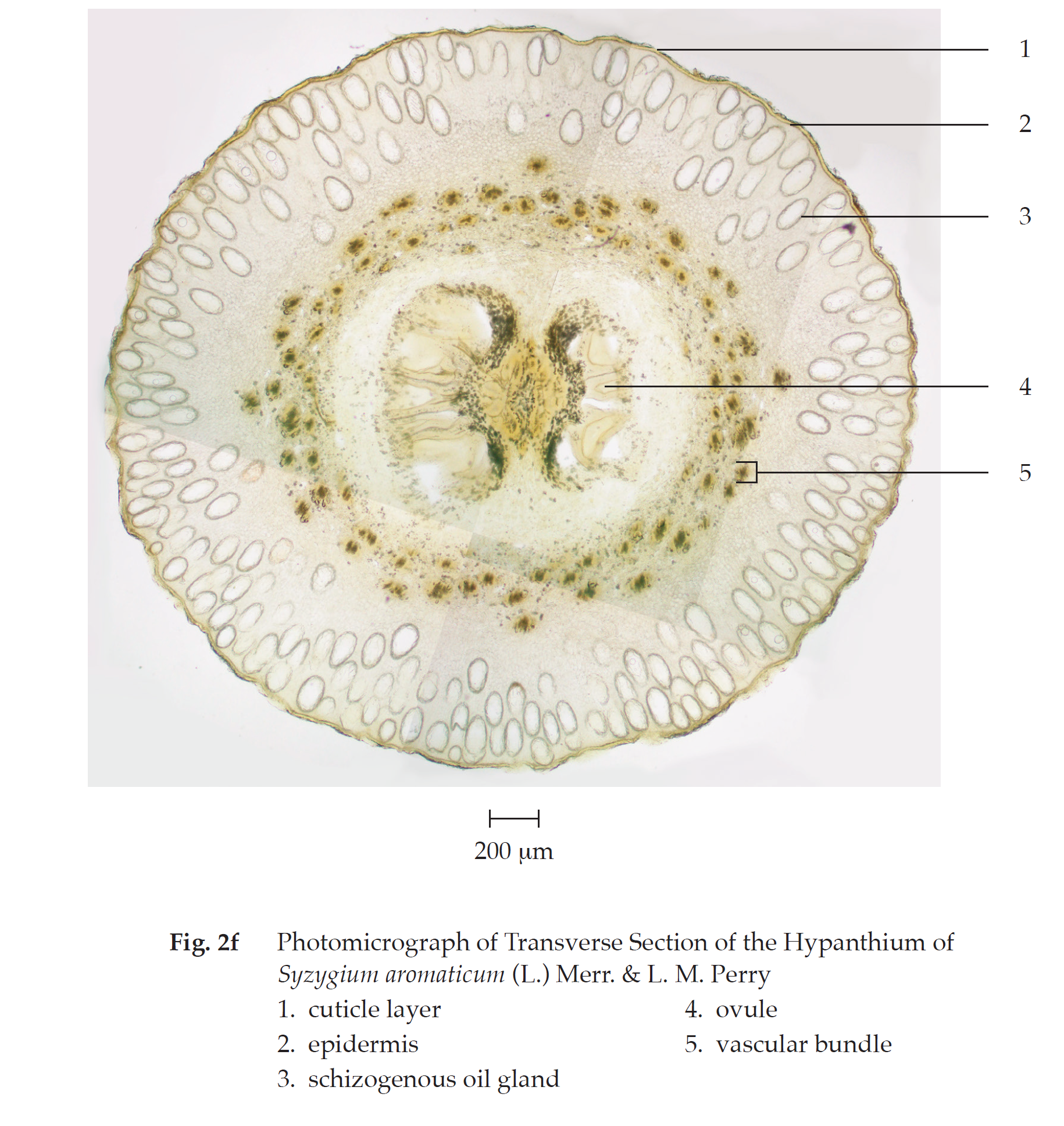
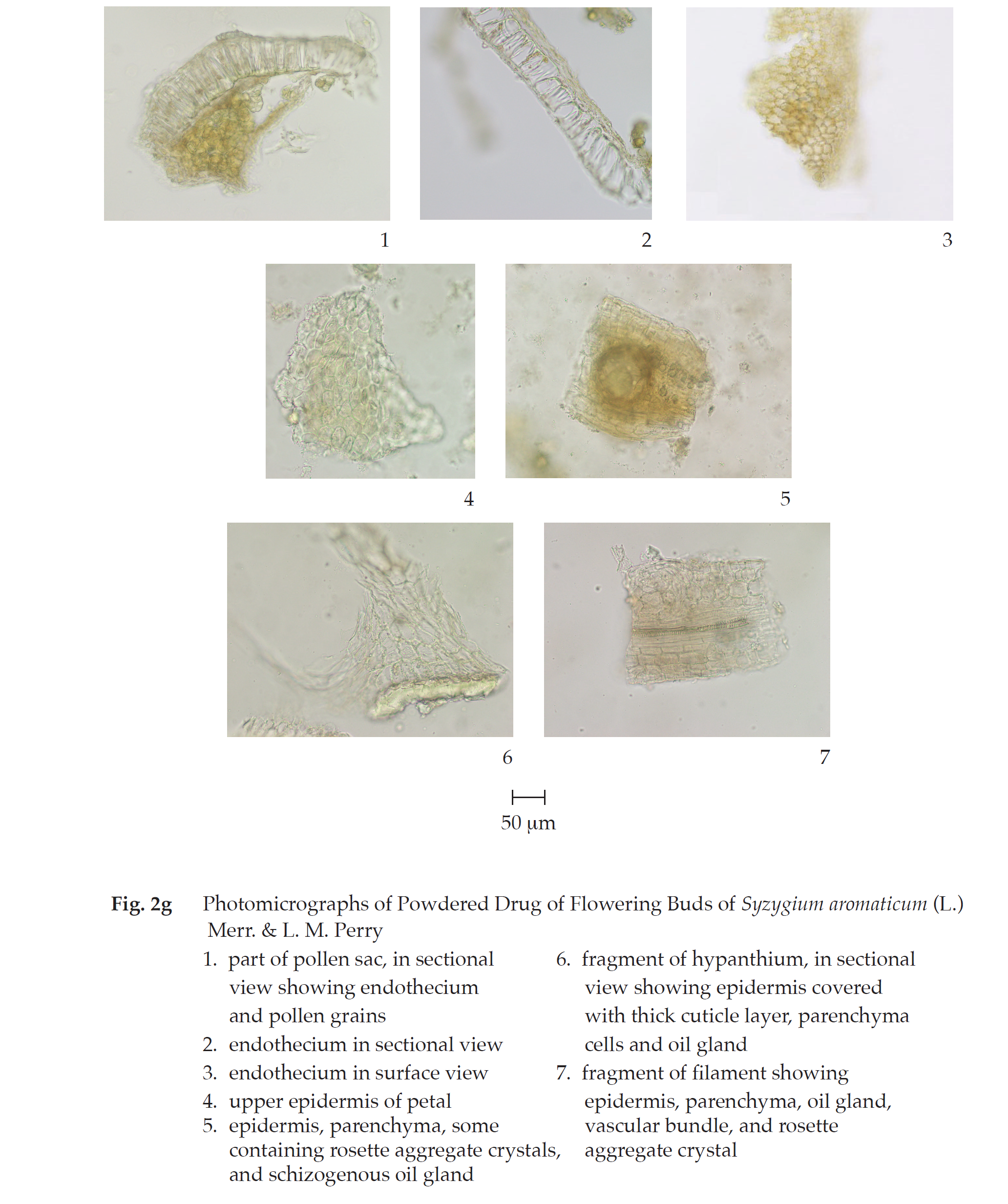
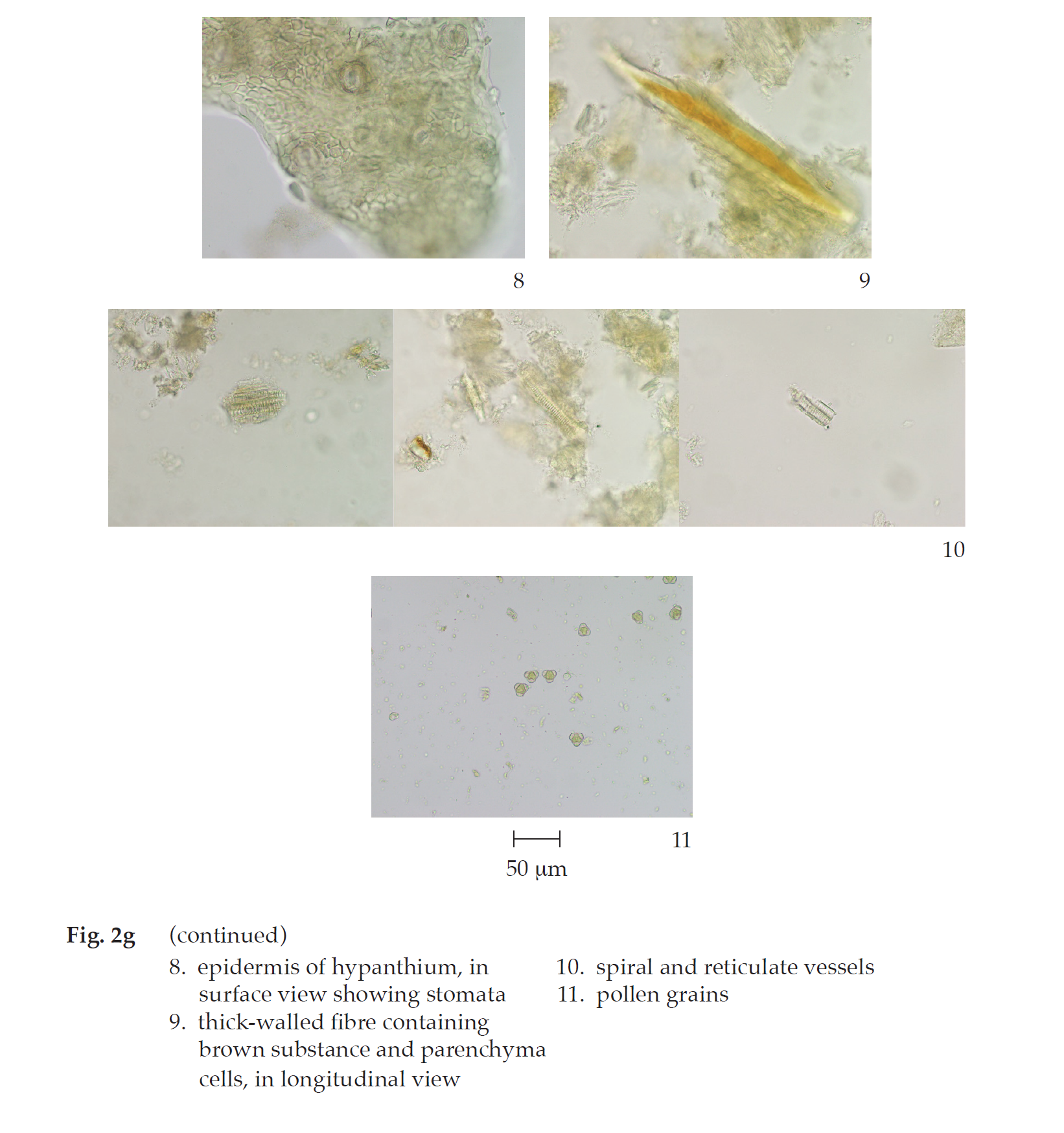
In surface view, the petal shows both upper and lower polygonal epidermal cells, with underlying oil droplets, rosette aggregate crystals and schizogenous oil glands.
Transverse section of the sepal shows upper epidermis, mesophyll, vascular tissue, and lower epidermis. Upper epidermis: a layer of thick-walled rectangular cells, covered with thick cuticle layer. Mesophyll: thick-walled parenchyma, some containing oil droplets, starch grains and rosette aggregate crystals; 1 to 2 rows of large schizogenous oil glands. Vascular tissue: bicollateral bundles and semi-pericyclic fibres. Lower epidermis: a layer of
thick-walled rectangular cells, slightly raised stomata and covered with thick cuticle layer.
In surface view, the sepal shows both upper and lower rectangular epidermal cells, with numerous oil droplets, prismatic crystals, slightly raised stomata, and underlying schizogenous oil glands.
Transverse section of the filament shows epidermis with papillae and thin cuticle layer, large schizogenous oil glands, slightly thick-walled round parenchyma cells, some containing rosette aggregate crystals and a strand of vascular tissue in the centre. However, transverse section of the anther shows 4-lobed pollen sac with pollen grains, a layer of small rectangular epidermis covered with thin cuticle layer, a layer of endothecium cells, thinwalled
parenchyma and a strand vascular tissue in the centre.
Transverse section of the hypanthium through the ovary shows epidermis, mesophyll, vascular tissue, and ovary. Epidermis: a layer of rectangular cells and slightly raised stomata, covered with thick cuticle layer. Mesophyll: numerous schizogenous oil glands; slightly thick-walled parenchyma, some containing rosette aggregate crystals, loosen small parenchyma near the centre; angular collenchyma. Vascular tissue: bicollateral vascular bundles. Ovary: 2-loculed, and axile placentation.
Clove in powder possesses the microscopic diagnostic of the unground drug. Fragment of hypanthium covered with thick cuticle and numerous oil glands, fragment of filament with oil glands, and endothecium are characteristic. Parenchyma cells containing rosette aggregate crystals are frequently found.
Packaging and storage Clove shall be kept in well-closed containers, preferably of metal or glass, protected from light, and stored in a cool and dry place.
Identification
A. Reflux 1 g of the sample, in No. 250 powder, with 10 mL of methanol for 10 minutes and filter. To 2 mL of the filtrate, add a few drops of a 1 per cent w/v solution of iron(III) chloride and shake well: a dark blue colour develops.
B. Carry out the test as described in the “Thin-Layer Chromatography” (Appendix 3.1), using silica gel GF254 as the coating substance and a mixture of 100 volumes of hexane and 10 volumes of acetone as the mobile phase. Apply separately to the plate, 15 µL of solution (A) and 3 µL of solution (B). For solution (A), macerate 1 g of the sample, in No. 250 powder, with 10 mL of dichloromethane for 30 minutes and filter. For solution (B), dilute 200 µL of eugenol with methanol to 2 mL and mix. After removal of the plate, allow it to dry in air. Examine the plate under ultraviolet light (254 nm), marking the quenching spots. The chromatogram obtained from solution (A) shows a quenching spot (hRf value 38 to 48), corresponding to the eugenol spot obtained from solution (B). Subsequently spray the plate with anisaldehyde TS and heat at 105° for 5 minutes; the spot corresponding to eugenol is purple. One pink, two purple and three violet spots are also observed (Fig. 3).
Water Not more than 8.0 per cent v/w (Azeotropic Distillation Method, Appendix 4.12).
Foreign matter Not more than 2.0 per cent w/w (Appendix 7.2).
Total ash Not more than 7.0 per cent w/w (Appendix 7.7).
Ethanol-soluble extractive Not less than 18.0 per cent w/w (Appendix 7.12).
Water-soluble extractive Not less than 22.0 per cent w/w (Appendix 7.12).
Volatile oil Not less than 20.0 per cent v/w, calculated on the anhydrous basis. (Appendix 7.3H). Use 5 g, in No. 250 powder, freshly prepared and accurately weighed. Use 100 mL of water as the distillation liquid and a 500-mL round-bottomed flask. Distil at a rate of 2 to 3 mL per minute for 5 hours. Use 2.0 mL of xylene in the graduated tube.
